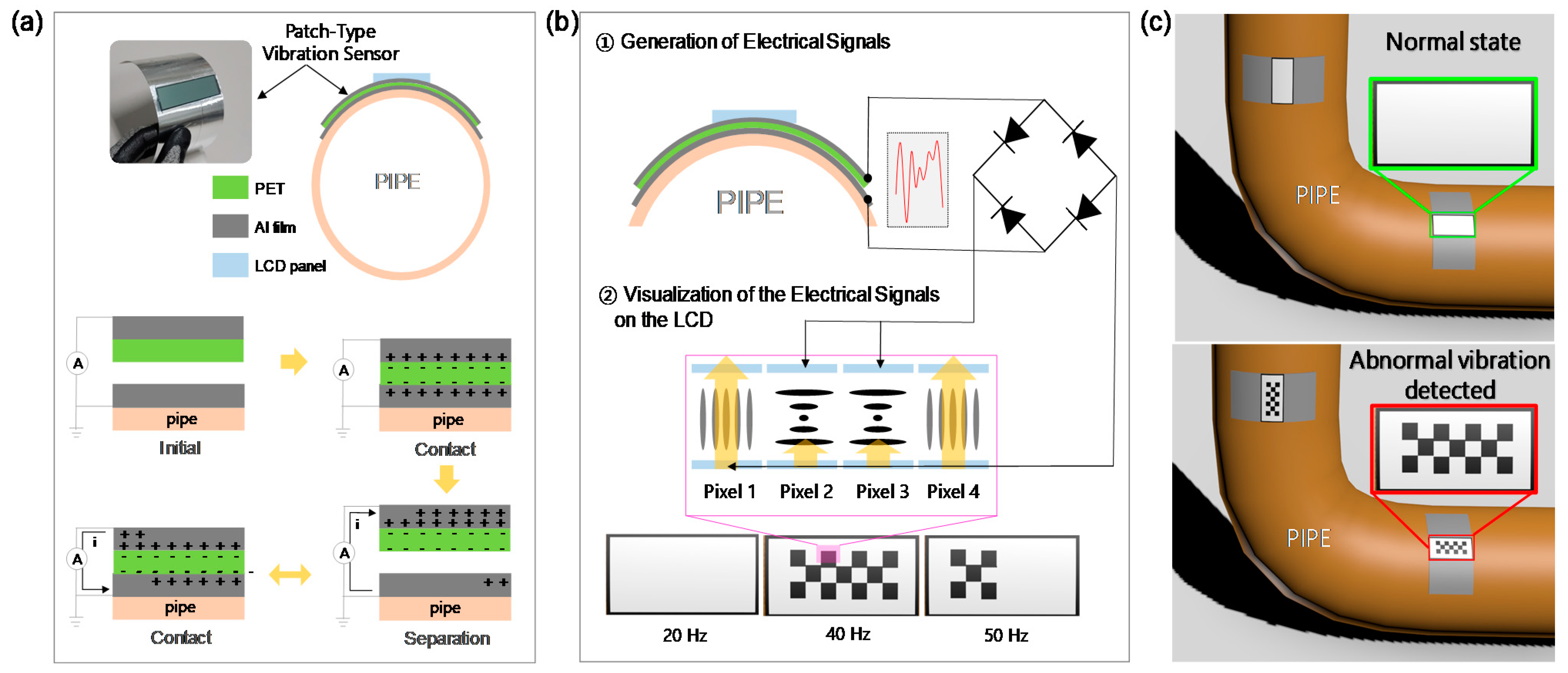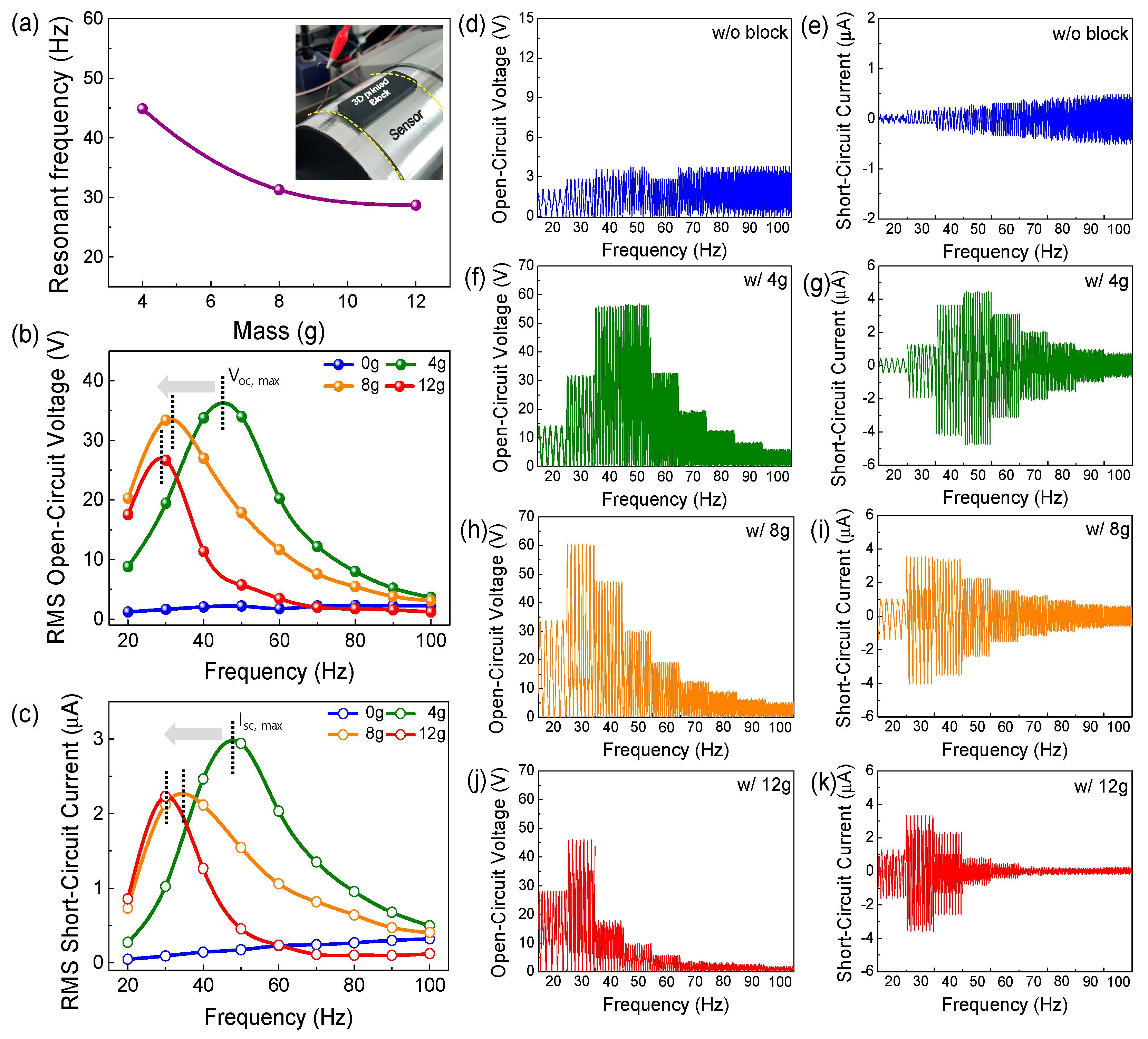Patch-Type Vibration Visualization (PVV) Sensor System Based on Triboelectric Effect
Abstract
1. Introduction
2. Materials and Methods
2.1. Materials and Operating Principle
2.2. Characerization and Measurement
3. Results
3.1. Resonant Frequency Tuning
3.2. Image Signal Encoding/Decoding Technique
4. Conclusions
Supplementary Materials
Author Contributions
Funding
Institutional Review Board Statement
Informed Consent Statement
Data Availability Statement
Conflicts of Interest
References
- Liu, J.; Seraoui, R.; Vitelli, V.; Zio, E. Nuclear power plant components condition monitoring by probabilistic support vector machine. Ann. Nucl. Energy 2013, 56, 23–33. [Google Scholar] [CrossRef]
- Ma, J.; Jiang, J. Applications of fault detection and diagnosis methods in nuclear power plants: A review. Prog. Nucl. Energy 2011, 53, 255–266. [Google Scholar] [CrossRef]
- Şeker, S.; Ayaz, E.; Türkcan, E. Elman’s recurrent neural network applications to condition monitoring in nuclear power plant and rotating machinery. Eng. Appl. Artif. Intell. 2003, 16, 647–656. [Google Scholar] [CrossRef]
- Morozov, S.A.; Kovtun, S.N.; Budarin, A.A.; Dvornikov, P.A.; Kudryaev, A.A.; Kondratovich, F.V.; Shutov, P.S.; Shvetsov, D.M. Development of an acoustic leak monitoring system. At. Energy 2007, 103, 925–931. [Google Scholar] [CrossRef]
- Hessel, G.; Schmitt, W.; Weiss, F.-P. A neural-network approach for acoustic leak monitoring in pressurized plants with complicated topologies. Control Eng. Pract. 1996, 4, 1271–1276. [Google Scholar] [CrossRef]
- Koo, I.S.; Kim, W.W. The development of reactor coolant pump vibration monitoring and a diagnostic system in the nuclear power plant. ISA Trans. 2000, 39, 309–316. [Google Scholar] [CrossRef]
- Jung, J.C.; Seong, P.H. An improved method for reactor coolant pump abnormality monitoring using power line signal analysis. Nucl. Eng. Des. 2006, 236, 57–62. [Google Scholar] [CrossRef]
- Cao, Y.; He, Y.; Zheng, H.; Yang, J. An alarm method for a loose parts monitoring system. Shock. Vib. 2012, 19, 753–761. [Google Scholar] [CrossRef]
- Chang, Y.W.; Jung, J.-C.; Seong, P.-H. Algorithm automation for nuclear power plant Loose Parts Monitoring System. Nucl. Eng. Des. 2004, 231, 99–107. [Google Scholar] [CrossRef]
- Peng, Z.; Kessissoglou, N. An integrated approach to fault diagnosis of machinery using wear debris and vibration analysis. Wear 2003, 255, 1221–1232. [Google Scholar] [CrossRef]
- Ahmadi, H.; Mollazade, K. Fault diagnosis of an electro pump in a marine ship using vibration condition monitoring. Insight 2009, 51, 431–438. [Google Scholar] [CrossRef]
- Wang, J.; Hu, H. Vibration-based fault diagnosis of pump using fuzzy technique. Measurement 2006, 39, 176–185. [Google Scholar] [CrossRef]
- Chen, H.-Y.; Hou, J.; Zhang, S.; Liang, Y.; Yang, G.; Yang, Y.; Yu, L.; Wu, Y.; Li, G. Polymer solar cells with enhanced open-circuit voltage and efficiency. Nat. Photonics 2009, 3, 649–653. [Google Scholar] [CrossRef]
- Albrecht, S.; Rech, B. Perovskite solar cells: On top of commercial photovoltaics. Nat. Energy 2017, 2, 16196. [Google Scholar] [CrossRef]
- Renaud, M.; Fiorini1, P.; Schaijk, R.V.; Hoof, C.V. Harvesting energy from the motion of human limbs: The design and analysis of an impact-based piezoelectric generator. Smart Mater. Struct. 2009, 18, 035001. [Google Scholar] [CrossRef]
- Roundy, S.; Wright, P.K. A piezoelectric vibration based generator for wireless electronics. Smart Mater. Struct. 2004, 13, 1131. [Google Scholar] [CrossRef]
- Kim, S.J.; We, J.H.; Cho, B.J. A wearable thermoelectric generator fabricated on a glass fabric. Energy Environ. Sci. 2014, 7, 1959–1965. [Google Scholar] [CrossRef]
- Kim, C.S.; Lee, G.S.; Choi, H.; Kim, Y.J.; Yang, H.M.; Lim, S.H.; Lee, S.-G.; Cho, B.J. Structural design of a flexible thermoelectric power generator for wearable applications. Appl. Energy 2018, 214, 131–138. [Google Scholar] [CrossRef]
- Zhang, X.; Gao, Q.; Gao, Q.; Yu, X.; Cheng, T.; Wang, Z.L. Triboelectric Rotary Motion Sensor for Industrial-Grade Speed and Angle Monitoring. Sensors 2021, 21, 1713. [Google Scholar] [CrossRef] [PubMed]
- Wang, Y.-L.; Deng, H.-T.; Ren, Z.-Y.; Liu, X.-T.; Chen, Y.; Tu, C.; Chen, J.-L.; Zhang, X.-S. The Interface between Nanoenergy and Self-Powered Electronics. Sensors 2021, 21, 1614. [Google Scholar] [CrossRef] [PubMed]
- Phan, T.K.; Wang, S.; Wang, Y.; Wang, H.; Xiao, X.; Pan, X.; Xu, M.; Mi, J. A Self-Powered and Low Pressure Loss Gas Flowmeter Based on Fluid-Elastic Flutter Driven Triboelectric Nanogenerator. Sensors 2020, 20, 729. [Google Scholar] [CrossRef] [PubMed]
- Wu, C.; Fan, C.; Wen, G. Self-Powered Speed Sensor for Turbodrills Based on Triboelectric Nanogenerator. Sensors 2019, 19, 4889. [Google Scholar] [CrossRef]
- Seol, M.-L.; Han, J.-W.; Park, S.-J.; Jeon, S.-B.; Choi, Y.-K. Hybrid energy harvester with simultaneous triboelectric and electromagnetic generation from an embedded floating oscillator in a single package. Nano Energy 2016, 23, 50–59. [Google Scholar] [CrossRef]
- Zhang, B.; Zhang, L.; Deng, W.; Jin, L.; Chun, F.; Pan, H.; Gu, B.; Zhang, H.; Lv, Z.; Yang, W.; et al. Self-Powered Acceleration Sensor Based on Liquid Metal Triboelectric Nanogenerator for Vibration Monitoring. ACS Nano 2017, 11, 7440–7446. [Google Scholar] [CrossRef]
- Wang, Z.L. Triboelectric nanogenerators as new energy technology and self-powered sensors—Principles, problems and perspectives. Faraday Discuss. 2014, 176, 447–458. [Google Scholar] [CrossRef]
- Kim, W.-G.; Kim, D.-W.; Tcho, I.-W.; Kim, J.-K.; Kim, M.-S.; Choi, Y.-K. Triboelectric Nanogenerator: Structure, Mechanism, and Applications. ACS Nano 2021, 15, 258–287. [Google Scholar] [CrossRef]
- Niu, S.; Wang, S.; Lin, L.; Liu, Y.; Zhou, Y.S.; Hu, Y.; Wang, Z.L. Theoretical study of contact-mode triboelectric nanogenerators as an effective power source. Energy Environ. Sci. 2013, 6, 3576. [Google Scholar] [CrossRef]
- Seol, M.-L.; Woo, J.-H.; Lee, D.-I.; Im, H.; Hur, J.; Choi, Y.-K. Nature-Replicated Nano-in-Micro Structures for Triboelectric Energy Harvesting. Small 2014, 10, 3887–3894. [Google Scholar] [CrossRef]
- Seol, M.-L.; Lee, S.-H.; Han, J.-W.; Kim, D.; Cho, G.-H.; Choi, Y.-K. Impact of contact pressure on output voltage of triboelectric nanogenerator based on deformation of interfacial structures. Nano Energy 2015, 17, 63–71. [Google Scholar] [CrossRef]
- McCarty, L.S.; Whitesides, G.M. Electrostatic Charging Due to Separation of Ions at Interfaces: Contact Electrification of Ionic Electrets. Angew. Chem. Int. Ed. 2008, 47, 2188–2207. [Google Scholar] [CrossRef] [PubMed]
- Apodaca, M.M.; Wesson, P.J.; Bishop, K.J.M.; Ratner, M.A.; Grzybowski, B.A. Contact Electrification between Identical Materials. Angew. Chem. Int. Ed. 2010, 49, 946–949. [Google Scholar] [CrossRef] [PubMed]
- Baytekin, H.T.; Patashinski, A.Z.; Branicki, M.; Baytekin, B.; Soh, S.; Grzybowski, B.A. The Mosaic of Surface Charge in Contact Electrification. Science 2011, 333, 308–312. [Google Scholar] [CrossRef]
- Nguyen, V.; Yang, R. Effect of humidity and pressure on the triboelectric nanogenerator. Nano Energy 2013, 2, 604–608. [Google Scholar] [CrossRef]
- Lee, M.; Bae, J.; Lee, J.; Lee, C.-S.; Hong, S.; Wang, Z.L. Self-powered environmental sensor system driven by nanogenerators. Energy Environ. Sci. 2011, 4, 3359–3363. [Google Scholar] [CrossRef]
- Li, S.; Liu, D.; Zhao, Z.; Zhou, L.; Yin, X.; Li, X.; Gao, Y.; Zhang, C.; Zhang, Q.; Wang, J.; et al. A fully self-powered vibration monitoring system driven by dual-mode triboelectric nanogenerators. ACS Nano 2020, 14, 2475–2482. [Google Scholar] [CrossRef] [PubMed]
- Torah, R.; Glynne-Jones, P.; Tudor, M.; O’Donnell, T.; Roy, S.; Beeby, S. Self-powered autonomous wireless sensor node using vibration energy harvesting. Meas. Sci. Technol. 2008, 19, 125202. [Google Scholar] [CrossRef]




Publisher’s Note: MDPI stays neutral with regard to jurisdictional claims in published maps and institutional affiliations. |
© 2021 by the authors. Licensee MDPI, Basel, Switzerland. This article is an open access article distributed under the terms and conditions of the Creative Commons Attribution (CC BY) license (https://creativecommons.org/licenses/by/4.0/).
Share and Cite
Kim, S.-J.; Seol, M.-L.; Chung, B.-Y.; Jang, D.-S.; Kim, J.-H.; Choi, Y.-C. Patch-Type Vibration Visualization (PVV) Sensor System Based on Triboelectric Effect. Sensors 2021, 21, 3976. https://doi.org/10.3390/s21123976
Kim S-J, Seol M-L, Chung B-Y, Jang D-S, Kim J-H, Choi Y-C. Patch-Type Vibration Visualization (PVV) Sensor System Based on Triboelectric Effect. Sensors. 2021; 21(12):3976. https://doi.org/10.3390/s21123976
Chicago/Turabian StyleKim, Sun-Jin, Myeong-Lok Seol, Byun-Young Chung, Dae-Sic Jang, Jong-Hwan Kim, and Young-Chul Choi. 2021. "Patch-Type Vibration Visualization (PVV) Sensor System Based on Triboelectric Effect" Sensors 21, no. 12: 3976. https://doi.org/10.3390/s21123976
APA StyleKim, S.-J., Seol, M.-L., Chung, B.-Y., Jang, D.-S., Kim, J.-H., & Choi, Y.-C. (2021). Patch-Type Vibration Visualization (PVV) Sensor System Based on Triboelectric Effect. Sensors, 21(12), 3976. https://doi.org/10.3390/s21123976





